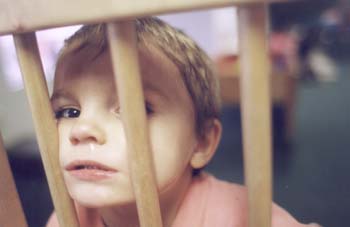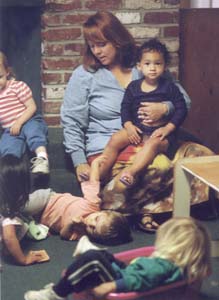![[MetroActive News&Issues]](/gifs/news468.gif)
[ Sonoma County | MetroActive Central | Archives ]
No Kiddin'
Someone to watch over them: One in 20 Sonoma County children soon will be unable to find suitable child care--a situation that family advocates say is reaching critical mass. Already there are 36,000 latchkey children ages 5 to 12 in the county.
Facing up to the child-care crisis
By Yosha Bourgea
LAWRENCE WANDERS through the small, crowded play area, picking up a toy that rings like a telephone. A high, wordless yelp comes from his mouth, as if in response. He is constantly in motion, his eyes glancing over the toys and books around him, an artless, toothy grin on his 8-year-old face.
Every so often he looks over the low wall at the rows of grown-ups, seated at a press conference called by Family Action of Sonoma County to discuss a predicted shortfall in child-care services in the county.
Diane Giampaoli, his mother, sits behind a table, talking about him to reporters. "It's difficult to get consistent day care," Giampaoli says. "Someone will say they can work with him, and then they meet him, and next week suddenly they can't do it."
Lawrence--who goes by the nickname "Lolo"--is autistic, and that makes the problem of finding child care for him especially hard. His mother has tried day-care centers, but none will accept him.
She understands why: her son's behavior requires special supervision, which most facilities are not prepared to provide.
But understanding the problem doesn't make it easier to solve.
"Day care for special-needs kids in Sonoma County does not exist," Giampaoli says flatly.
Indeed, a newly released report shows that special-needs children aren't the only ones coming up short. The crisis has been growing for years, quietly, out of the sensation-hungry eye of the news media. Hurricanes and shooting sprees are more exciting than the predicament of how to care for children. The new report, "Child Care: A Quiet Crisis in Sonoma County," shows that the crisis affects everyone, from businesses whose employees are distracted at work, wondering about the safety of their kids, to the 150,000 children who make up a third of the county's population.
The figures released last week by the Sonoma County Child Care Planning Council and Family Action are alarming. By this time next year, according to a recent report, it's anticipated that close to 7,500 local children who are in need of full- or part-time care will be unable to find it.
That's one in 20.
The council's two-year study is part of a state-mandated review that will be presented to local policymakers throughout the county. On Tuesday, Sept. 21, the agency will deliver its finding to the Board of Supervisors.
"We can't dodge this issue any longer," says Suzanne Shupe, director of Family Action of Sonoma County. "We need to address the problem as a community."
The demand for child care has grown steadily since World War II, when the two-parent, one-breadwinner family model began to decline. Today, only a third of the two-parent families in Sonoma County can afford to leave a parent at home during the day. And single parents, who make up 23 percent of all families in the county, don't have a choice.
Finding someone to watch their children, let alone take care of them, can be a week-to-week struggle.
Toddlers and infants are especially at risk. A report released last year by the Little Hoover Commission shows that brain development occurs primarily before age 3, and suggests that children who spend their earliest years in a safe and stimulating environment are more likely to grow up to be intelligent, well-adjusted adults.
But the report also shows that 40 percent of infant and toddler care in the country takes place in settings that are unsafe or unhealthy.
"The earlier you can intervene, the less expensive it is to solve a problem," says Petaluma City Council-member Jane Hamilton. "If you can help a child when they're 3, then when they're 15, they won't tend to be in Juvenile Hall costing taxpayers thousands of dollars."
Nurturing: Santa Rosa child-care worker LaMona Holt and friends.
Joan (her last name is withheld upon request) has eight clients on the waiting list for her Santa Rosa day care. "We're booked till next summer," she says.
Like Wayman, Joan has expanded to meet the growing demand from the community, although she doesn't advertise. Most of the children in her care belong to friends, and they provide all the business she can handle.
Unfortunately, the demand for child care rarely translates into higher wages for the people providing it, some of whom face stiff resistance from neighbors who argue against day-care businesses in residential areas. An offshoot of the crisis is the shortage of qualified staff in state-licensed child-care facilities, where many employees work for close to minimum wage.
Kenneth Jaffe, executive director of the International Child Resource Institute, says that people who have had years of higher education often find they can't afford to work in the field.
Many families rely on the public school system as a form of day care. But for parents who work later hours, a school day isn't long enough. It's estimated that almost one third of school-age children in the county need after-school care to cover their parents' working and commuting hours. United Way estimated recently that there are more than 36,000 "latchkey" children ages 5 to 12 in Sonoma County.
Some schools have opened their classrooms to after-hours care providers, but Jaffe guesses that less than half of schools in the county participate in such partnerships. It's not for lack of trying, he says--the problem is lack of space. The reduction of class size in recent years means that fewer rooms are available, and when space is limited, extracurricular programs are the first to go.
IN THE FACE of the crisis, community organizations are banding together to spread the word and work on solutions. Some school-age children in the Santa Rosa School District are taking advantage of Safe Havens for Youth, a free, federally funded after-school pilot program sponsored by United Way. If it remains successful, Safe Havens could be a model for similar programs throughout the county.
Significant headway already has been made through a new program, SonomaWORKS, which provides federal child-care subsidies for families moving off welfare. Subsidized child care helped close to 1,000 children in Sonoma County last year, but demand still far exceeds the supply. At River Child Care Services and the Community Child Care Council, two local resource and referral agencies, more than 2,000 families are now on the waiting list for subsidies. And low-income working families, who are not even eligible, are the hardest hit of all. Child-care costs can consume up to 25 percent of a family's budget--and when housing and food expenses compete for dollars, something important has to give.
But financially strapped parents have at least one political ally in Rep. Lynn Woolsey, D-Petaluma, herself a former welfare mother, who recently introduced legislation to increase the availability of child care for children whose parents work non-traditional hours or shifts.
"We're spending all this money on a missile defense system," says Woolsey. "You'd think we could spare some for the most important thing--our children."
[ Sonoma County | MetroActive Central | Archives ]
Copyright © Metro Publishing Inc. Maintained by Boulevards New Media.
![]()

Michael Amsler
 Michael Amsler
Michael Amsler
ROSE WAYMAN began running a small day care out of her home in 1985, when she was pregnant with her second child. Last month, she got approval from the Santa Rosa Planning Commission to expand her facility from six children to 12. "I've always had a waiting list," Wayman says. "That's why I expanded. We have a baby starting next week who was on the list before her mom got pregnant."
From the September 16-23, 1999 issue of the Sonoma County Independent.